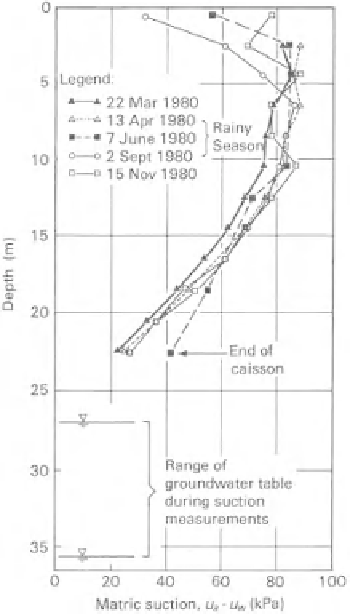Environmental Engineering Reference
In-Depth Information
Table 12.10 Strength Properties for Soils of Example 2
The next analysis was performed by taking matric suc-
tion into consideration [i.e.,
c
u
w
)
tan
φ
b
]. The
matric suction profile of September 2, 1980, was used in the
analysis. In this case, the cross section was divided into sub-
strata drawn parallel to the water table in order to account
for the varying matric suctions with depths. The critical fac-
tor of safety corresponding to the measured matric suction
profile was 1.25. In other words, matric suctions appear to
have increased the factor of safety by 20%.
c
+
=
(u
a
−
c
φ
φ
b
Unit Weight
(kN/m
3
)
Soil Type
(kPa)
(deg)
(deg)
Completely weathered
rhyolite
18.4
10.1
42.6
12.0
Completely to highly
weathered rhyolite
21.4
12.0
43.9
12.0
12.7.2 Extended Shear Strength Method
The application of the slope stability formulation using the
“extended shear strength” equation for unsaturated soil is
illustrated in the following example (Ng, 1988). A cross
section for a typical steep slope in Hong Kong was selected
for analysis. The role of the negative pore-water pressures
is shown by computing the factor of safety of the slope for
a variety of pore-water pressure conditions. The slope was
first subjected to a flux at ground surface in order to simu-
late a severe rainfall condition. As a result, the pore-water
pressure increases (i.e., matric suction decreases). The factor
of safety of the slope is shown to decrease with decreasing
matric suctions. The influence of various
φ
b
values on the
computed factors of safety is illustrated.
A transient water flow analysis was used to calculate neg-
ative pore-water pressure changes resulting from a heavy
rainfall. The pore-air pressures were assumed to remain
atmospheric (i.e.,
u
a
=
0) for both the seepage and slope
stability analyses.
12.7.2.1 General Layout of Problem and Soil Properties
The example slope has an inclination angle of approximately
60
◦
to the horizontal. Its height is about 38 m. The cross
section of the slope along with its stratigraphy is shown
in Fig. 12.97. The slope mainly consists of decomposed
granitic residual soil. The upper 5m is a layer of collu-
vium overlaying a layer of completely decomposed granite.
Below is a layer of completely to highly decomposed gran-
ite. A thick layer of highly decomposed granite lies at the
bottom of these strata. The face of the slope is covered
by a thin layer of low-permeability, cement-lime stabilized,
decomposed granite plaster called chunam.
Several soil properties related to permeability and shear
strength are required for the analyses. The saturated coeffi-
cients of permeability are presented in Table 12.11.
Unsaturated coefficient of permeability functions were
calculated using the saturated coefficients of permeability
along with the SWCCs of the soil (Green and Corey,
1971a). The SWCCs for the colluvium and the completely
decomposed granite are shown in Fig. 12.98. Data from the
SWCCs along with the saturated coefficients of permeability
were used to establish the relationship between the unsat-
urated coefficients of permeability
k
w
and matric suction
(Lam and Fredlund, 1984). The computed values were then
Figure 12.96
In situ measurements of matric suction throughout
1980 for example 2 (from Sweeney, 1982).
tensiometers installed vertically along an exploratory caisson
shaft near the cut slope. The matric suction profiles measured
through the rainy season of 1980 are plotted in Fig. 12.96.
The profiles of matric suction remained essentially constant
with some variations near the surface due to infiltration as
well as fluctuations of the groundwater table.
Slope stability analyses were performed on section
A
-
A
(Fig. 12.95) using circular slip surfaces passing through the
toe of the slope. The analytical procedure was the same as
that followed in example 1. The critical factor of safety
for the cut slope, when not
taking matric suction into
c
), was approximately 1.05. The
relatively low factor of safety indicated a potential unstable
condition, although no signs of distress were observed.
consideration (i.e.,
c
=













Search WWH ::

Custom Search